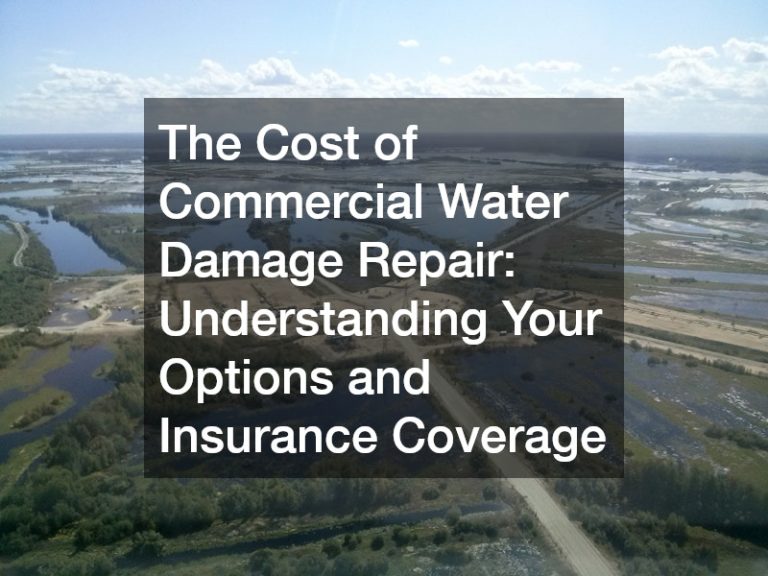Commercial water damage can be a significant setback for businesses, often leading to substantial repair costs and operational disruptions. Whether caused by a burst pipe, a severe storm, or a roof leak, water damage can affect the structural integrity of a building, damage valuable equipment, and necessitate extensive cleanup. Understanding the costs associated with commercial water damage repair and the role of insurance coverage is crucial for business owners to effectively manage and mitigate such incidents.
Assessing the Cost of Commercial Water Damage Repair
The cost of commercial water damage repair can vary widely depending on several factors.
These include the extent of the damage, the size of the affected area, the type of water involved, and the specific restoration services required. Here’s a breakdown of key cost components:
Initial Assessment and Inspection:
Before any repair work can begin, a thorough inspection and assessment are necessary. This step involves identifying the source of the water damage, determining the extent of the impact, and evaluating the necessary remediation steps. Professional assessment fees can range from a few hundred to several thousand dollars, depending on the complexity of the situation.
Water Extraction and Drying:
It’s important to remove standing water and dry the affected areas to prevent further damage and mold growth. The cost of water extraction and drying typically depends on the volume of water and the size of the affected space. Specialized equipment such as industrial dehumidifiers and air movers are often required, adding to the overall expense.
Structural Repairs and Restoration:
Water damage can compromise the structural integrity of a building, requiring repairs to walls, floors, ceilings, and other structural components. The cost of these repairs varies based on the severity of the damage and the materials needed for restoration. Additionally, if mold remediation is necessary, it can significantly increase the overall repair costs.
Content Restoration:
In many cases, commercial water damage affects not only the building structure but also the contents within, such as furniture, electronics, and inventory. Restoring or replacing these items can be a substantial part of the total repair cost. Professional restoration services can salvage many items, but severely damaged contents may need to be replaced.
Preventive Measures:
To avoid future water damage, businesses may need to invest in preventive measures such as improving drainage systems, waterproofing, and installing water detection devices. While these costs are additional, they are essential for long-term protection and can help reduce the likelihood of recurring issues.
Navigating Insurance Coverage for Water Damage Repair
Insurance coverage plays a vital role in managing the financial impact of commercial water damage repair. Understanding your insurance policy and the extent of coverage can make a significant difference in how you handle such incidents. Here are some key points to consider:
Policy Review:
Regularly review your insurance policy to understand what types of water damage are covered. Standard commercial property insurance policies typically cover sudden and accidental water damage, such as burst pipes or appliance malfunctions. However, gradual damage resulting from maintenance issues may not be covered.
Flood Insurance:
Standard commercial property insurance usually doesn not include flood damage. If your business is in a flood-prone area, a separate flood insurance would be really helpful. This coverage can protect against damage caused by natural flooding events.
Business Interruption Insurance:
Water damage can disrupt business operations, leading to lost revenue and additional expenses. Business interruption insurance can help cover the loss of income and operational costs incurred during the restoration period. Ensure your policy includes this coverage for comprehensive protection.
Documentation and Claims Process:
In the event of water damage, document the extent of the damage with photographs and detailed descriptions. Promptly notify your insurance provider and follow their claims process. Keep records of all repair estimates, receipts, and correspondence to support your claim.
Working with Professionals:
Engage reputable commercial water damage repair professionals who have experience working with insurance claims. They can provide detailed assessments and documentation required by insurers, streamlining the claims process and ensuring you receive the maximum coverage.
Conclusion
Commercial water damage repair can be a costly and complex process, but understanding the associated costs and insurance coverage options can help businesses navigate these challenges more effectively. By being proactive, regularly reviewing insurance policies, and investing in preventive measures, business owners can mitigate the impact of water damage and ensure a quicker recovery. In the face of unexpected water damage, having a well-prepared strategy and working with experienced professionals can make all the difference in protecting your business and its assets.
.





